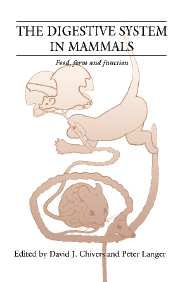Book contents
- Frontmatter
- Contents
- List of contributors
- Preface
- Part I Introduction
- Part II Food
- 5 Foods and the digestive system
- 6 Classification of foods for comparative analysis of the gastro-intestinal tract
- 7 The ‘carnivorous’ herbivores
- 8 Nutritional ecology of fruit-eating and flower-visiting birds and bats
- 9 Herbivory and niche partitioning
- 10 Taste discrimination and diet differentiation among New World primates
- 11 Potential hominid plant foods from woody species in semi-arid versus sub-humid sub-tropical Africa
- Part III Form
- Part IV Function
- Part V Synthesis and perspectives
- Index
11 - Potential hominid plant foods from woody species in semi-arid versus sub-humid sub-tropical Africa
Published online by Cambridge University Press: 18 March 2010
- Frontmatter
- Contents
- List of contributors
- Preface
- Part I Introduction
- Part II Food
- 5 Foods and the digestive system
- 6 Classification of foods for comparative analysis of the gastro-intestinal tract
- 7 The ‘carnivorous’ herbivores
- 8 Nutritional ecology of fruit-eating and flower-visiting birds and bats
- 9 Herbivory and niche partitioning
- 10 Taste discrimination and diet differentiation among New World primates
- 11 Potential hominid plant foods from woody species in semi-arid versus sub-humid sub-tropical Africa
- Part III Form
- Part IV Function
- Part V Synthesis and perspectives
- Index
Summary
One question, posed from the perspective of an ecologist studying wild-plant food species, that is appropriate to a discussion of the digestive system in mammals is ‘how are potential plant food diets affected by changes in climate, in particular a drier climate versus a wetter climate with increased seasonality?’
Our interests lie in the edible flora of sub-Saharan Africa and the evolution of the hominid diet. In this chapter when we speak of edible plant foods we are referring to hominids. In its extreme form, this interest can be expressed as the African Dietary Hypothesis: it is the African sub-tropical flora in partiicular that has nurtured human evolution through most of the earth's recent pre-history; this is the nutritional environment to which our dietary physiology is most fundamentally adapted. An extreme position to be sure, perhaps only partially true.
To return to our initial question about climate and equitability of the nutritional environment, the climate of sub-tropical Africa is dominated by strong seasonality: summer rain systems primarily, with restricted bimodal zones (Fig. 11.1) where failure of the lesser rains often results in a seasonal pattern similar to that of the summer rain zones. Theoretically, one might expect a gradient of increasing seasonality of potential diet in the sub-tropical zones, with a notable difference, for example, between a drier climate with greater seasonal temperature extremes and a wetter climate with more equitable seasonal differences in temperature. This gradient and type of contrast should be most readily seen in Africa south of the equator, with decreasing annual precipitation and cooler winters associated with hotter summers across a broad geographic area.
- Type
- Chapter
- Information
- The Digestive System in MammalsFood Form and Function, pp. 166 - 192Publisher: Cambridge University PressPrint publication year: 1994
- 6
- Cited by



